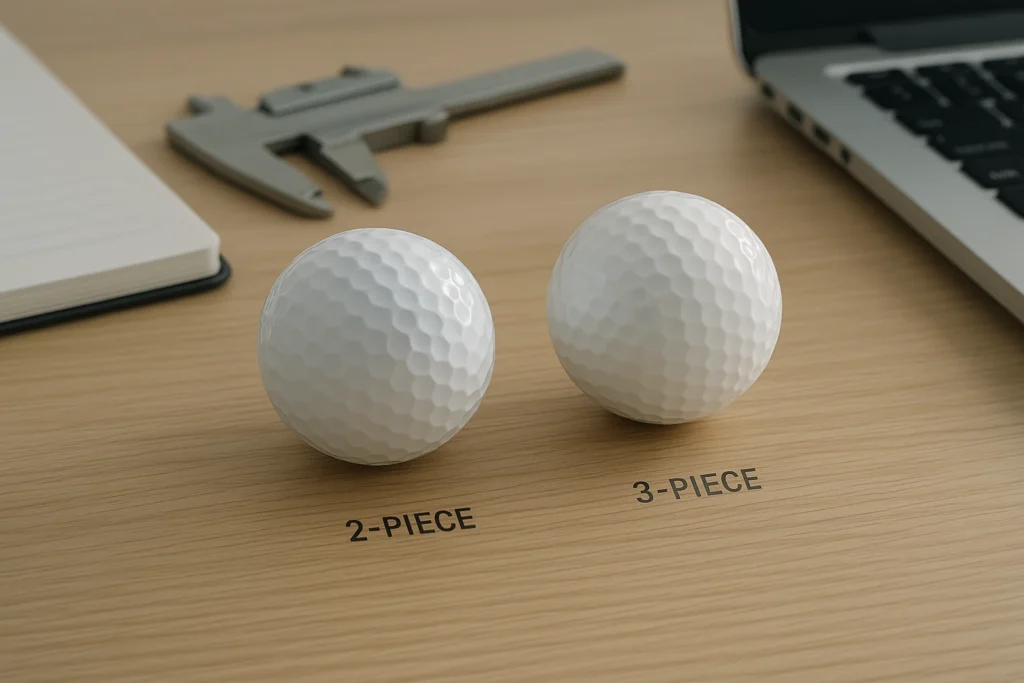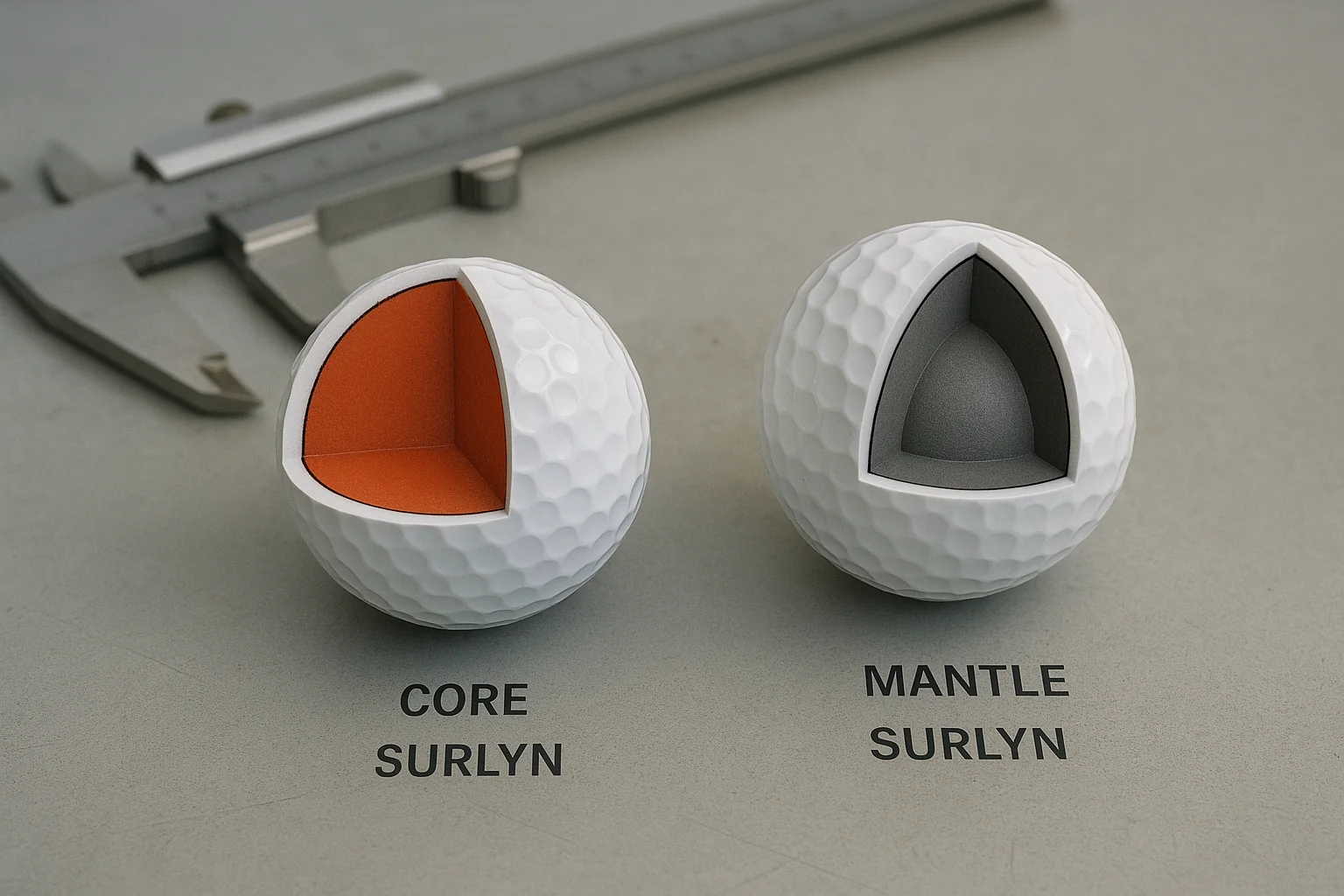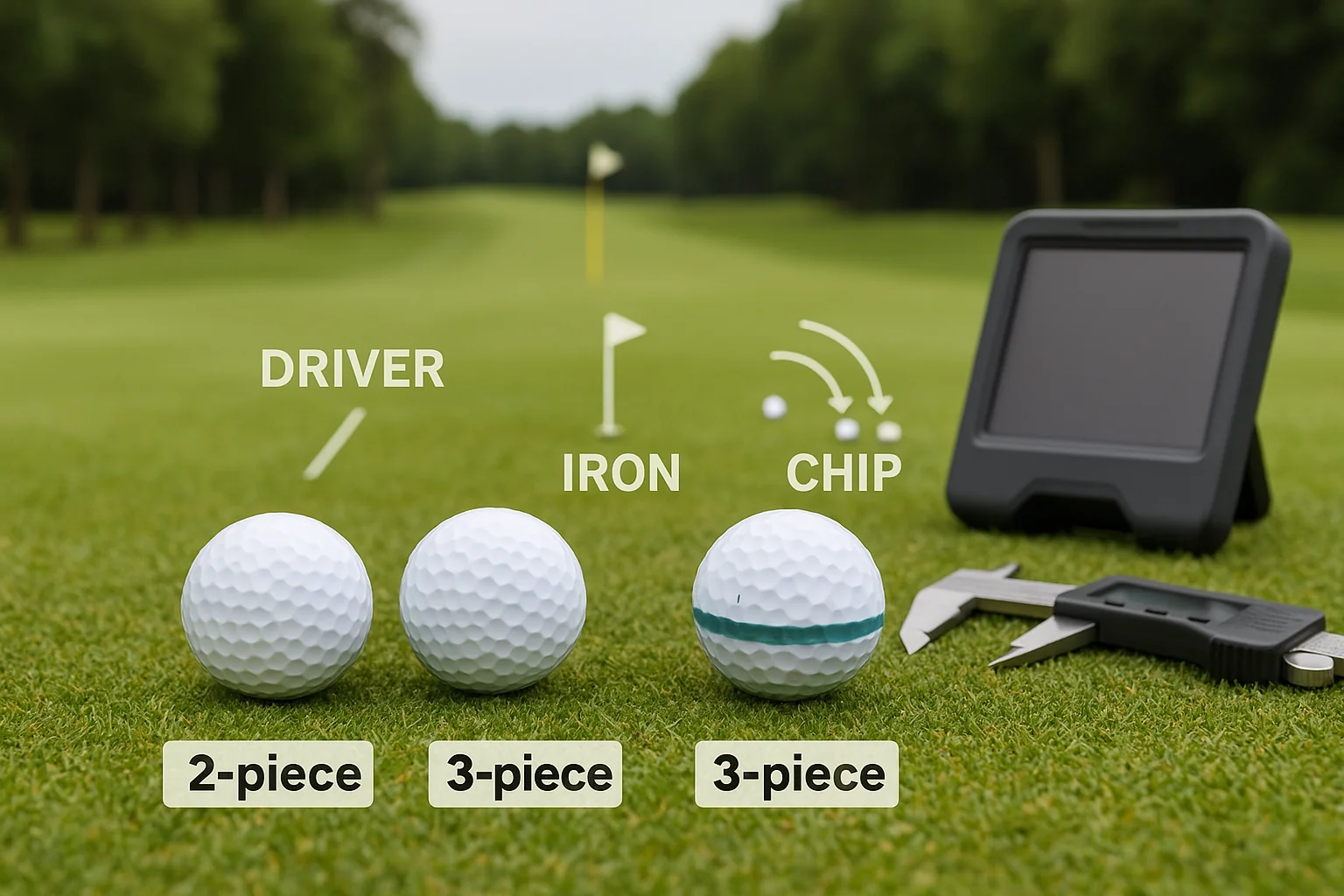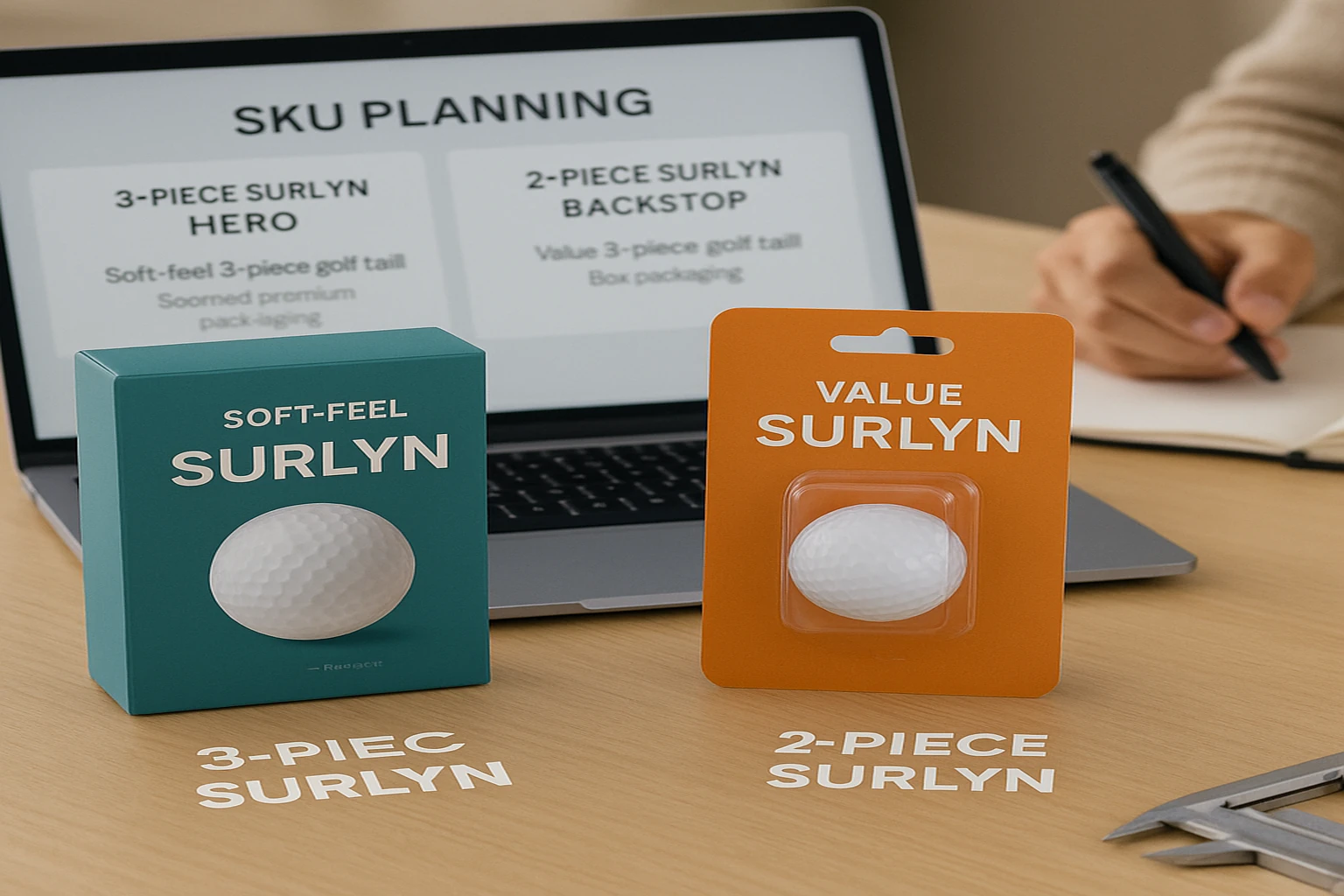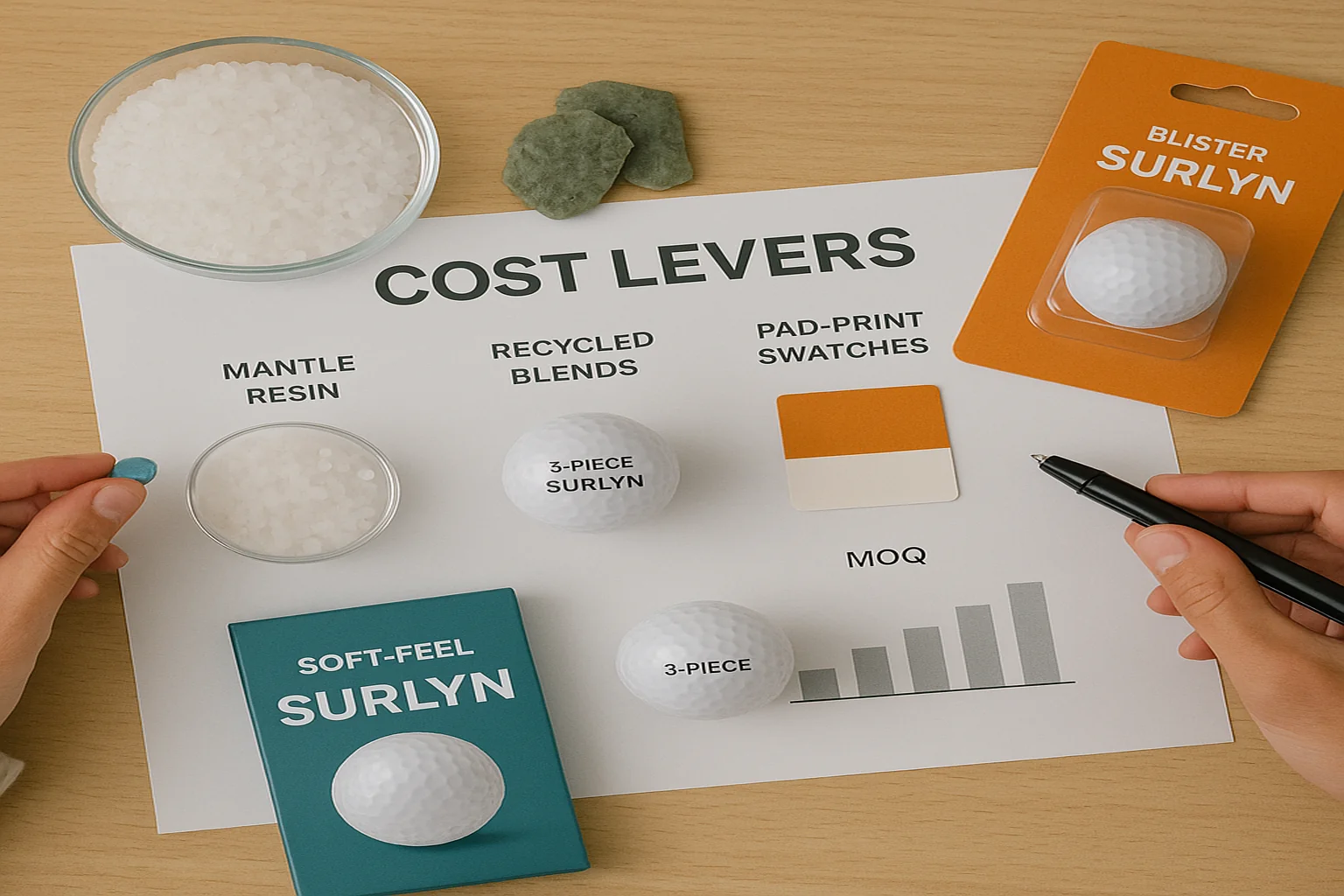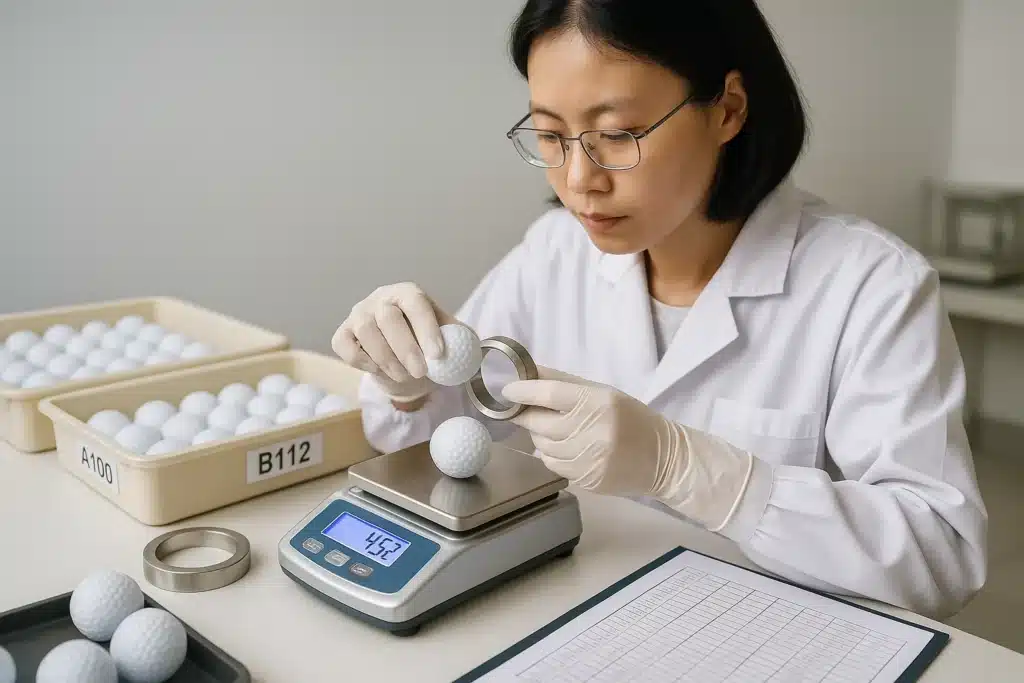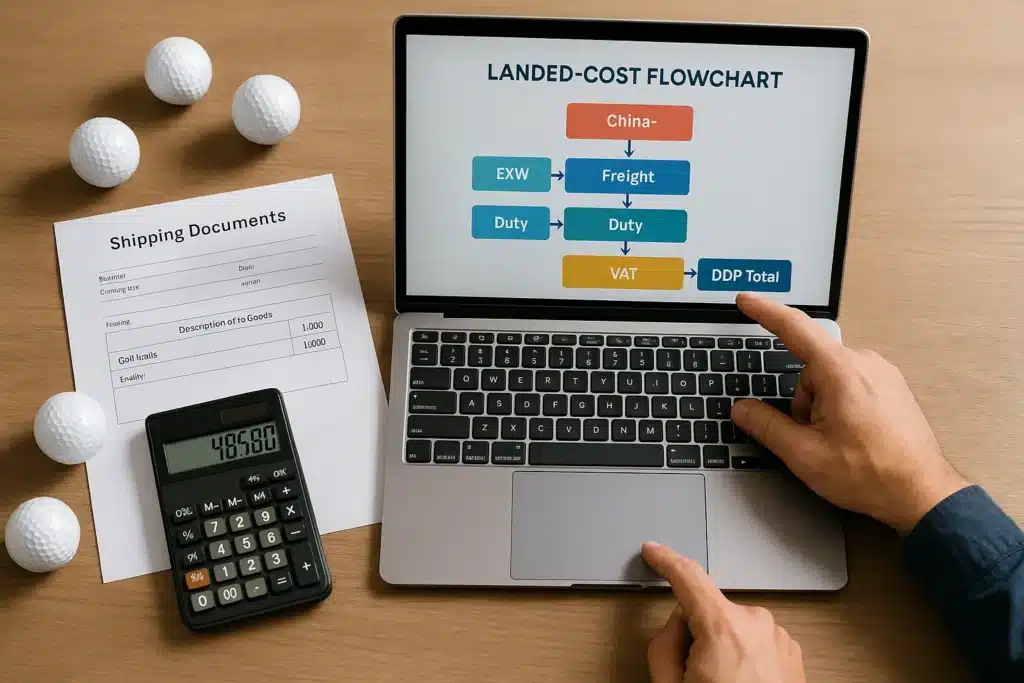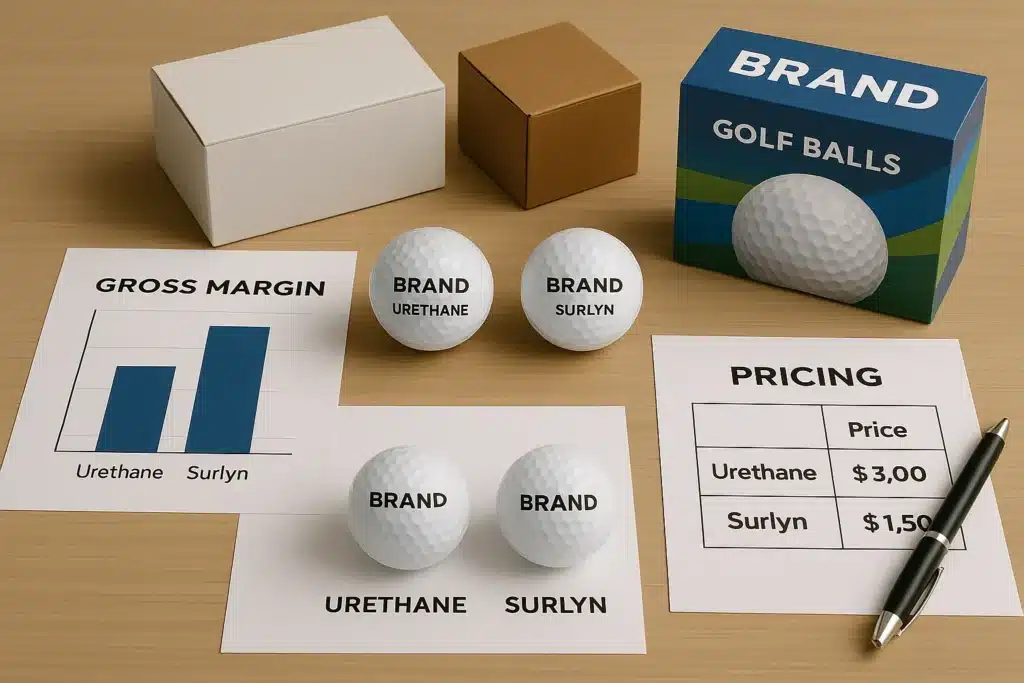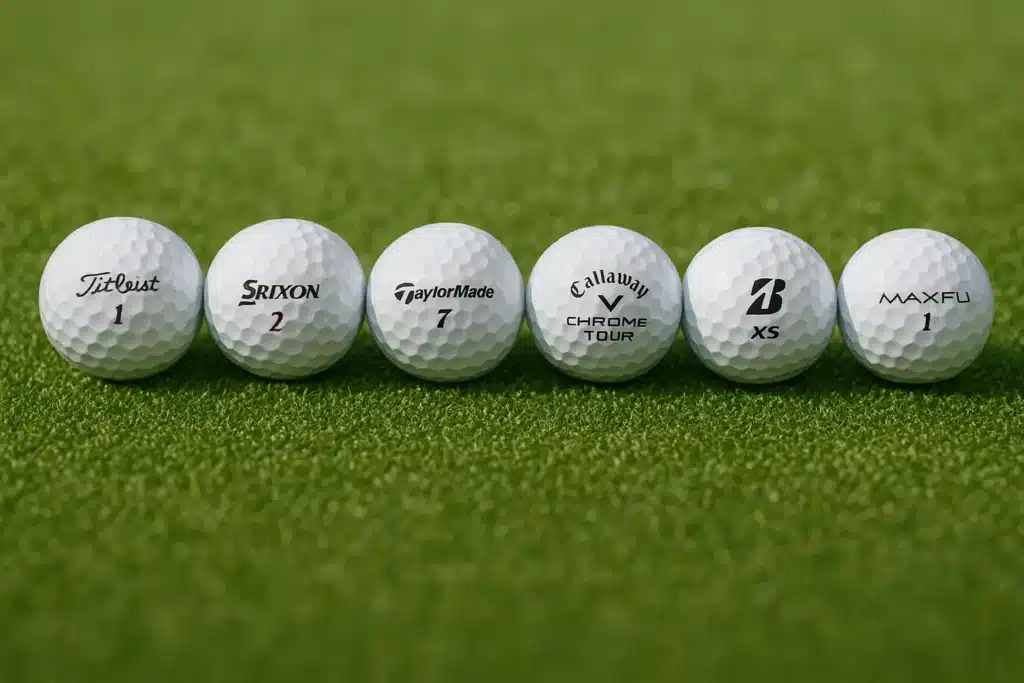You want a quick, buyer-level answer that turns into clear selection rules for e-commerce and B2B gifting—without losing control of cost, print, or supply rhythm. This guide translates the difference between 2 and 3 piece Surlyn construction into performance, positioning, and purchasing moves you can act on today.
What’s the core difference between 2-piece and 3-piece Surlyn balls?
A 2-piece ball pairs a large core with an ionomer (Surlyn® family) cover for distance, straight flight, and durability. A 3-piece adds a mantle between core and Surlyn, enabling finer spin/launch tuning and a softer, more layered feel—especially on short shots—without jumping to urethane pricing.
Key Parameters (Surlyn cover for both)
| Dimension | 2-piece Surlyn | 3-piece Surlyn | Why it matters |
|---|---|---|---|
| Structure | Core + Surlyn | Core + mantle + Surlyn | Mantle = spin/feel tuning |
| Compression (target) | 70–95 (broad) | 70–95 (segmentable) | Mantle lets you split by swing speed |
| Driver spin/launch | Low spin, straight | Low–mid spin; launch/side-spin tunable | Helps wind stability/side-spin control |
| Short-game spin | Low–mid | Mid (vs 2-piece) | Shorter first hop, closer stop |
| Feel | Firmer, “poppy” | Softer-layered | Sound/hand feel more refined |
| Durability | Excellent | Excellent | Surlyn cover advantage |
| Target user | Beginners, practice, price-sensitive | Mid-handicap, value seekers wanting more check | Bridges to urethane feel at lower cost |
✔ True — 3-piece Surlyn offers more greenside control than 2-piece at similar compression
The mantle lets engineers adjust spin windows and impact feel without changing the cover family.
✘ False — “3-piece Surlyn equals tour-level spin”
Urethane covers still deliver higher wedge spin and one-hop-stop behavior for elite play.
Construction: core + Surlyn vs core + mantle + Surlyn
A classic 2-piece is core + Surlyn cover. A 3-piece inserts a mantle (ionomer/copolymer blend) between the core and cover. The mantle acts like a transmission: it modulates energy transfer and spin, allowing similar driver launch with more greenside control at equal compression bands.
Mantle roles: spin modulation, side-spin stability, feel
The mantle can nudge driver side-spin lower and raise short-game spin vs a comparable 2-piece, while creating a “firmer outside, softer inside” hand feel—slightly steadier flight in wind and shorter first hop.
Surlyn vs urethane
Surlyn ionomer is tough, cut-resistant, and low-spin off the tee; urethane wins on greenside spin but can scuff sooner and costs more. A 3-piece Surlyn stays below urethane in wedge spin, yet improves feel/control over a 2-piece.
How do they perform on course—driver, irons, and short game?
Both are low-spin off the driver; 3-piece can steady launch and side-spin slightly. With 7–9 irons, 3-piece trends a touch higher in spin/landing angle. From 50–100 yards and chips, 3-piece typically stops sooner; 2-piece releases more. Both are durable thanks to Surlyn.
Driver/tee shots (wind stability, side-spin)
Expect similar ball speed and low driver spin. A well-tuned mantle can reduce side-spin leakage and tighten dispersion, especially in wind. Distance gaps are usually small at typical amateur speeds.
Mid-to-short irons (peak/landing differences)
3-piece designs often show a slightly higher spin/landing angle, helping hold mid-irons a bit better. It’s not urethane, but the approach tolerance near the flag improves relative to a firm 2-piece.
Chips/pitches (first-bounce length, rollout)
From 50–100 yards and greenside, 3-piece Surlyn typically shortens the first hop and reduces rollout compared with 2-piece, which releases longer. That’s the practical, on-green difference most players actually feel.
In one glance (performance takeaways):
- Driver: both low-spin; 3-piece steadier launch/side-spin control in wind.
- Irons: 3-piece tends to slightly higher spin/landing angle for hold.
- Short game: 3-piece shorter first hop, tighter stop; 2-piece more rollout.
- Durability: Surlyn on both = cut/scuff resistance and longevity.
- Distance myth: with same compression/aero, distance gap is usually small.
Which should I choose for my users and channels?
Choose 2-piece when users prize distance, durability, price, and logo gifting. Choose 3-piece when you want noticeably better short-game check and softer feel without a big price jump—ideal for e-commerce storytelling about the difference between 2 and 3 piece Surlyn.
- 2-piece: distance, durability, bulk gifts, practice, price-sensitive users
- 3-piece: softer feel, better check inside 100 yds, weekend scoring
- E-commerce ladder: hero = 3-piece; value backstop = 2-piece
- Retail/range: ranges favor 2-piece; performance shelves highlight 3-piece
Selection principles (distance/price vs feel/check)
If your audience is practice-heavy, price-sensitive, or gifting at scale, default to 2-piece. If they care about chips/check and weekend scoring but don’t want urethane, anchor a 3-piece.
Player profile mapping (beginner, mid-handicap)
- Beginners / slower speeds: 2-piece value builds confidence and saves budget.
- Mid-handicap / mixed speeds: 3-piece Surlyn gives a noticeable feel uplift and closer stops inside 100 yards.
Channel mapping (retail, range, gifts, events)
Ranges and entry retail lean 2-piece; e-commerce performance lines and event sets shine with 3-piece positioning.
Scenario → Recommended Layering
| Channel/Use | Prefer 2-piece | Prefer 3-piece | Why |
|---|---|---|---|
| Entry retail | ✅ | Backup | Lower price, less decision friction |
| Driving range/practice | ✅✅ | – | Durability, recovery, cost |
| Logo gifts/general events | ✅✅ | ✅ | Budget sets = 2p; premium sets = 3p |
| E-commerce hero | – | ✅✅ | “Soft feel, better check” story converts |
| Higher-tier retail value line | – | ✅ | Urethane-like message at lower cost |
| Mid-handicap (10–24) | Backup | ✅✅ | Perceptible gains around green |
| Bulk practice | ✅✅ | – | High consumption, unit cost priority |
How should I position SKUs for e-commerce and B2B gifting?
For e-commerce hero, lead with 3-piece “soft feel, better check” and backstop with value 2-piece. For B2B gifts, use 2-piece white + logo with controlled packaging; upgrade to 3-piece for business sets or event partnerships to highlight stopping power and feel. Add copy variants like “best 3-piece Surlyn soft feel” on product tiles to capture soft-feel intent.
E-commerce hero vs value SKU
- Hero: 3-piece Surlyn (soft-feel copy, short-game visuals, comparison claims vs 2-piece).
- Value backstop: 2-piece for price filters and “practice or bulk gifts.”
B2B gift tiers: standard vs premium
- Standard: 2-piece white + 1–2 color pad print; blister or simple sleeve to protect budget.
- Premium: 3-piece with upgraded gift box, message “soft feel not pricey; better check.”
Messaging snippets (“soft feel not pricey”)
- “Soft feel, better check—without urethane price.”
- “Durable Surlyn cover for practice and play; mantle-tuned control when it matters.”
What cost levers keep 3-piece competitive without losing margin?
Use copolymer/ionomer blends and recycled mantle content (where allowed) to hit $0.5x EXW; keep pad printing to 1–2 spot colors to avoid UV full-color premiums. Control MOQ and packaging to protect unit economics. (Indicative supplier listings show 2-piece Surlyn often below 3-piece, with overlapping ranges depending on spec, MOQ, and print.)
Mantle material strategies (copolymer, recycled)
Specify approved recycled mantle blends and QC checkpoints (compression, coefficient of restitution). You’ll keep feel gains while avoiding a raw-material shock.
Printing choices (1–2 color pad print vs UV)
1–2 spot-color pad prints usually meet corporate logo needs for gifts and bulk; reserve UV full-color for brand-critical campaigns due to unit cost and cycle time.
Packaging: gift box vs blister cost control
Use gift sleeves/boxes for premium sets; blister or bulk for training and budget gifts. Supplier catalogs commonly list these options with tiered MOQs.
Cost Drivers and Settings
| Driver | 2-piece impact | 3-piece impact | Recommendation |
|---|---|---|---|
| Mantle resin | – | Adds material cost | Approve copolymer blends; allow recycled content with QC |
| Printing | 1–2 pad colors | Same; UV adds more | Default 1–2 pad colors; limit UV to hero SKUs |
| Packaging | Blister/bulk cheapest | Gift box for premium | Match channel: blister for practice, box for gifting |
| MOQ tiers | Often lower | Sometimes higher | Use tiered MOQ; sample before mass |
| Yield/line time | Simpler, faster | Added step/mold | Lock materials; minimize changeovers in peak |
| Aerodynamics (dimple) | Keep constant | Keep constant | Hold dimple pattern constant to isolate layer/compression effects |
Action checklist (cost levers):
- Pre-approve copolymer/recycled mantle ratios and QC points.
- Limit to 1–2 pad colors; reserve UV for hero SKUs only.
- Tier packaging: practice = blister/bulk; gifting = sleeves/boxes.
- Before peak, lock Surlyn pellets and mantle resin to reduce changeovers.
Can typical consumers really feel the difference—and is it worth the upcharge?
Most golfers won’t see large driver distance changes. They’ll notice shorter first hop and softer feel with 3-piece on chips and short approaches. If play frequency and greenside scoring matter, the modest upcharge is usually justified; for practice/social play, 2-piece wins on value.
Perception by swing speed bands
- <80 mph: Distance differences are minimal; feel preference decides.
- ~95 mph typical: 3-piece’s landing/rollout control is more noticeable.
- >105 mph: Urethane may become attractive for maximum wedge spin.
Use frequency and willingness to pay
Weekly players who track up-and-down rates will sense value in 3-piece; casual or range-only users should bank savings on 2-piece.
User Type → Perceived Gain → Recommend
| User Type | Perceived gain | Recommend |
|---|---|---|
| Casual/practice-first | Durability, price | 2-piece |
| Weekend mid-caps | Softer feel, shorter hop | 3-piece |
| Corporate gifting | Clean logo, budget | 2-piece (standard) |
| Event/partner packs | Premium perception, better check | 3-piece |
Who are reliable Chinese suppliers for 2- and 3-piece Surlyn balls?
Shortlist suppliers that can produce both 2- and 3-piece with MOQs ~100–3000 balls, stable pad/UV printing, and gift/blister packaging. Validate compression windows, mantle options, and peak-season capacity before PO.
Supplier Capability Snapshot
| Factory | Region | 2p | 3p | MOQ* |
|---|---|---|---|---|
| Golfara | Ningbo, Zhejiang | ✅ | ✅ | 1,000 balls (typical) |
| JTS (Xiamen) Sports Equipment | Xiamen, Fujian | ✅ | ✅ | ~1,000–1,200+ (by spec) |
| MLG Sports Equipment | Xiamen, Fujian | ✅ | ✅ | ~1,000–2,000 |
| Youli Sports Equipment | Dongguan, Guangdong | ✅ | ✅ | Variable/low-MOQ listings |
| JTS (Alibaba channel) | Xiamen, Fujian | ✅ | ✅ | 2,000–3,000 (tiered) |
| Xiamen Zest Industry | Xiamen, Fujian | ✅ | ✅ | ~2,000 |
FAQ
Will a 3-piece Surlyn actually stop faster on wedges?
Yes—typically by shortening the first hop and reducing rollout versus a comparable 2-piece, though not to urethane levels.
A mantle lets engineers raise relative short-game spin within the Surlyn family, producing a more controlled hop-and-stop pattern from 50–100 yards and on chips. It’s the most noticeable, real-world difference for mid-handicappers.
If I only stock one SKU for e-commerce, which should be my hero?
Lead with a 3-piece Surlyn as your performance story; keep a 2-piece value SKU as a price catcher.
“Soft feel, better check—not pricey” resonates online and justifies modest premium. The 2-piece protects conversion on price filters and bulk buys. This two-SKU ladder covers most demand curves efficiently.
What compression bands should I request for mixed swing speeds?
Target mid bands (≈70–90) with one softer and one firmer option if you run two compressions.
Compression interacts with cover/mantle. A softer mid band improves feel/launch for moderate speeds; a firmer option aids faster players. Keep aerodynamics consistent across layers so buyers attribute feel differences correctly.
How do I keep 3-piece costs in the $0.5x EXW range?
Approve copolymer/recycled mantle blends and limit printing to 1–2 pad colors; reserve UV full-color for premium runs.
Supplier quotes vary with spec, MOQ, and packaging. Lock materials early and standardize cartons to hold EXW.
What packaging keeps gifts premium without blowing budget?
Use sleeves or simple gift boxes for premium feel; blister for training/value sets.
Sleeves and compact boxes signal quality while controlling materials and freight. Blister is tough and cost-efficient for practice. Mirror common catalog formats to speed quoting and sampling.
What MOQs and lead times should I expect in peak season (Apr–Sep)?
Plan ~1,000–3,000 MOQs and pad your lead time; lock materials early.
Tiered MOQs by print/pack are common, and peak-month lead times lengthen. Pre-booking Surlyn pellets and mantle resin reduces slippage and protects campaign dates.
Can I offer color options without hurting durability or timelines?
Yes, but standard white runs are fastest; colors add pigment/QC steps.
Surlyn remains durable, yet colorways require pigment matching and print tests that can nudge timelines. Offer white as default, add one accent color for limited campaigns.
Will beginners notice any distance loss moving to 3-piece?
Usually no meaningful loss; differences are modest off the driver.
Layering mostly affects spin windows and feel. For slower swingers, ball speed parity keeps distance similar. The greenside benefits of 3-piece may not justify the price if the priority is practice or budget.
Is pad printing enough for corporate logos, or do I need UV full-color?
Pad printing (1–2 spot colors) is enough for most logos; use UV full-color for photo-heavy or gradient marks.
Pad keeps unit cost and cycle time tight. UV adds setup and per-unit costs; reserve it for hero SKUs or brand-critical briefs.
How should I split capacity between 2-piece and 3-piece SKUs?
Use a 6:4 split (2-piece:3-piece) through April–September, then rebalance by sell-through.
2-piece supports price-sensitive volume and practice; 3-piece secures performance stories. Lock materials early and group runs by print/layer to cut changeovers.
Conclusion
For Surlyn-covered golf balls, the third layer (mantle) is your lever: 3-piece keeps driver distance close while adding greenside control and softer feel; 2-piece wins on price, durability, and volume. Lead your e-commerce with 3-piece soft-feel, keep a 2-piece value backstop, and plan a 6:4 capacity split in peak months.
You might also like — Range vs Game vs Tour Golf Balls: Differences in Performance, Price, Construction, and Origin

